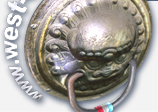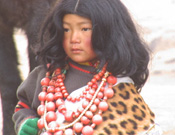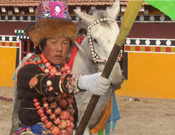|
Three Tibetan Festivals In Amdo and Kham
(Eastern Tibet)
Day 1. In the fly
Day 2. Arrive at
Beijing
Day 3. Beijing
Day 4.
In the morning, we fly to Lanzhou, a capital city of Gansu Province,
an important industry city in Northwest China (Alt: 1600m) and the
vital communication line of the old Silk Road. Nothing interesting
is to see inside the city except the Provincial Museum. We can visit
it in the afternoon, if time allows. Lanzhou Sunshine hotel, 3 star.
Day 5.
Drive 290km (7 hours) to Labrang (Alt: 2900m). On the way, 2/3 first
part of the road we pass the Chinese Muslim Hui people area with
many Mosques along the roadsides. Lunch is in Linxia Hui Autonomous
City, which is horned as "Small Hong Kong" by local people
as you can buy anything you want in this Moslem city. There is one
street specially selling Tibetan antiques and souvenirs, which is
worth seeing for half an hour as the prices may cheaper than Labrang.
At last part of the road wherever you see the white Chortans which
will make you felling you are in Tibetan area and landscape is much
more beautiful. Overseas hotel or other good hotels with facility
and hot water for shower.
Day 6.
In the morning we visit Labrang monastery built in 1709, now it
has 1000 monks. It is one of the six important Gelukpa (the Yellow
Sect) monasteries in whole Tibet and a center of Tibetan learning
in Eastern Tibet. We can find many Tibetan nomads who come here
for pilgrimage and to buy textiles for their clothing and jewellery
along numerous Tibetan shops. Overnight Labrang
Day 7.
After breakfast, we drive 130km about 4 hours to Repkong (Alt: 2400m).
On the way, we pass grassland, forestry, agricultural land and beautiful
Red Mountain valley. Hua Nan hotel or Post Hotel with facilities
and hot water for shower. In the afternoon, we visit the famous
Tibetan art school, Sengeshong Magotsang which was funded during
the 15th century and after 16th century Repkong became the home
town of Tibetan art in Amdo. All monks here have good training of
painting and sculptures and are often invited to make fine art works
in many monasteries or private houses by Tibetan in whole Tibet
even nowadays. We will visit some of monks' houses. Overnight Repkong
Day 8. Tongren (Repkong)
Tongren was in the past and is still today one of the most famous
central of Tangkha painting as well as the making of appliqu¨¦
Tangkhas. We have asked local people to demonstrate these two arts,
as well the making of clay sculptures. In the area there is a famous
hat maker who makes the yellow hats for the yellow sect monks and
lamas. This is a particularly interesting craft, which we also hope
to see. Other members of the family will show us monk robes and
cloaks so we have some idea of the huge amount of work that goes
into the making of these clothes. There will be visits to small
monasteries in the area and an opportunity to wander in the villages
of the Tibetan and Tu farmers who are not nomads but arable farmers
growing the important crops of wheat and barley that is the staple
food of all Tibetans. The valley at this time of year will be a
sea of longhaired barley surrounded by sand brown eroded hills with
single storied villages tucked into the hillside. It is a beautiful
scene.
Day 9 & 10. Tongren
(Repkong) Shaman Festival
The Tibetans of Tongren are Buddhists but in July there is a most
unusual secular festival in each of the villages, which has its
origins in pre-Buddhist traditions. The people reins act the Bon
traditions and they worship the Mountain Gods. No monks of the yellow
sect are allowed to watch. The shaman of each village conducts this
important ceremony which honors the local mountain god and asks
for the good health of the village and a successful harvest for
the local community. On the first day the image of the god is paraded
round the village and gifts are given of wine and barley. In only
one village in the second day goats are killed as a blood sacrifice
to the mountain god. This ceremony is early in the morning and if
you wish to avoid it you can stay at the hotel. In another village
butter effigies of a goat, sheep and yak are burnt as a sacrifice
to the god. Various ceremonies goon all day, watched by the whole
of the village dressed in their best clothes. The male members of
the village dance in front of the shaman and at the height of the
ceremony long needles are placed in their back and through their
mouths. The men continue dancing, with the needles implanted to
the beat of the goatskin drum. Beautifully costumed women dance
an elegant dance to the god. In-between costumed comedy skits are
enacted by villagers. Each village ceremony is a little different
and we will visit three different villages which have costumes and
traditions. Huangnan Hotel or Post Hotel **
Day 11. Repkong / Kumbum
A visit will be made to Kumbum Monastery, which has been well known
for many centuries all over Tibet, only 30km away from Xining. Kumbum
monastery was founded in 1560 to commemorate the birthplace of Tsongkhapa,
the founder of the Yellow Sect. The monastery was built round the
tree, which was the birthplace of Tsongkhapa. The Dalai Lama' brother
was for a short time abbot of the this spectacular monastery with
its great assembly where one can buy everything needed for monastic
life, as well as antiques and tourist trinkets for visiting pilgrims.
Perhaps one of the most interesting workshops is where they make
the great metal images of the wheel of life and the deer, which
usually surmount the temple roofs. Textile enthusiasts will be delighted
to find various embroidery materials as some antique embroidery.
One of the most interesting finds is the embroidered plait decoration
the Tu people wear. Overnight Qinghai Hotel ****
Day 12. Kumbum / Kokonor
Drive 150km to Kokonor, the biggest holy lake in Tibet and largest
salt lake in China, covers an area of 4581 Square KM, four times
big as Hong Kong. As early as three thousands years ago, Mongolia
and Tibetan nomadic people believed that a hundred per cent of the
holy lakes and the holy mountains contain unique treasures or minerals
underneath. Those minerals give out a kind of magnetism or spirit
to a few special sensitive Masters, like Shaman or Living Buddha,
through whom to teach people on how to respect and protect natures
in order to receive the good luck waves from those holy mountains
and lakes to have a good fate of life. In May of 1578, King of the
Mongols, Altan Qan gave the title Dalai Lama 3 to Sonam Gyatso at
east shore of Lake Kokonor. The Living Buddha system of Gelukpa
started since then. Overnight Qinghai Lake hotel**
Day 13. Kokonor / Madoi
Drive 330km to Mato, it means the place where the Yellow River originates.
The road from here to central Tibet has been considered one of the
most important roads for centuries. Overnight in local best hotel,
but no hot water for shower and facility in the room.
Day 14. Madoi / Jyekundo
(Yushu)
Drive 360km to Yushu (Tib: Jyekundo) County, alt: 3700m. Today's
driving is exiting; we pass the first bridge of the Yellow River,
the famous mountain pass Bayankala at elevation 5080m and upper
reaches of the Yangtze River. Those landscapes present an amazing
picture. Under the blue sky with white clouds, you see different
types of mountains decorated with pray flags, beautiful grassland
embellished with flock of yak and sheep, nomad's black and white
tents, the colorful dressed Golok and Khampa people, while some
different sects of old monasteries on the way without tourists to
visit, which brings you back to the nature. Overnight Yushu Hotel**
with facilities in the rooms and hot water for shower.
Day 15/16/17.
Yushu Horse Festival
Today is the opening day of the Tibetan Horse Fair. Nomadic families
and monks from the surrounding monasteries, dressed in their red
robes and finery drive or ride into the camping ground and set up
their tents for the festival. Everybody was dressed in his or her
best chubas and jewelers. Itinerant peddlers come with their wares
and local traders set up a big market. There is an opening parade
of horsemen, floats from the monasteries, dressed in their finery
and even costumes used for the lama dances. One of the most popular
programmers during the festival is Tibetan dancing. Costumed girls
and men whirl their long sleeves flying. The men's boots stamp out
a strong rhythm and their ankle bells ring; the crowds roar their
approval. The crowd also cheers Tibetan singers singing well-known
melodies. Perhaps the most popular events are horse racing, acrobatic
riding and shooting. Tibetan are fantastic horseman and the speed
of the their small of their steeds is phenomenal. Recently competitions
have been held for the best local costume. This gives a chance for
men and woman to wear their smartest clothes and oceans of jellerys.
As well as watching the various activities it is very pleasant to
stroll round the fair and meet the local people who often generously
invite you to tea and delicacies in their tents.
Day 18.
Drive 350km to Manigango, a very small and simple town as most of
Tibetan houses are built with timber. Many nomadic families come
here for shopping and to taste different food in this town which
brings you a strong feeling of old post. On the way we pass Sershul
monastery and one of the three important Nyingmapa monasteries Dzogchen
Gompa, just 3km away from the main road and 53km to Manigango but
it is hidden in a beautiful valley. (Tib: Dzogchen) monastery, one
of four important Nyingmapa Monasteries in Tibet, they are Katork,
Paiyul and Mindroling. It was built in 1684 on the advice of the
Dalai Lama 5 and from its location and background with all year
round snow-covered mountains, you can imagine how great and holly
it was during past hundreds of years. All foreigners who came here
said they were just in larger Switzerland, but altitude is 4023m.
Overnight Communication Hotel. No facility in the room, simple but
it's clean.
Day 19.
Before driving 110km to Ganzi, we must drive to the famous holly
and one of the most beautiful Lakes Yilhun Lhatso located 15km from
here on the way to Derge. Ganzi was once the largest and most important
town in Kham area during the 17th century. Ganzi Gonpa is in town
built in 1642 by Mongols. We must visit the oldest temple Den Gonpa,
a very important protector monastery for the area. Khampa hotel
or Golden Yak Hotel, with facilities and shower available in the
rooms.
Day 20.
There are two roads, if there is no rain we should drive half day
along a beautiful valley and visit one or two very old monasteries
hidden in this valley. Overnight Xinlong Guest House**. Another
is main road 300km to Xinduqiao (Tib: Dzongzhab) township, which
is a transportation hub for truck drivers' overnight. Stay in the
local best hotel but no shower and facility.
Day 21.
Drive 210km to Litang, which is honored as "Paradise on Earth"
by local Tibetan and the city was built on beautiful grassland at
altitude 4200m. Characterized by its large stone houses, people
here is very proud of the birthplace of the Dalai Lama 3 and 7.
We visit Litang Chode, built by Dalai Lama 3 in 1580. Overnight
in Highland Pearl Hotel or other better Hotels**.
Day 22/23/24.
We stay here for three days to enjoy the Litang Horse Race Festival,
which is different from any other Tibetan areas.
Day 25.
Drive km to Damba, the place where Tibetan Gyarong live. Gyarong
is another tribe, which is different from Golok and Khampa people.
They speak their dialect and maintained unique way of life and culture
for centuries. The dress is also distinctive. Most of the women
wear multi-coloured embroidered headscarves and elaborate belts
and aprons. Almost every family has its own blockhouse built with
stones, ascending to heights of between 30-60 meters, which kept
the powerful Sino-Manchu armies at bay for 10 years during 18th
century. Government Guesthouse.
Day 26.
Drive 340km to Chengdu, at first part, the Tibetan and Qiang farmer's
houses displayed at each side of the road are so varied and colorful
with strong characteristic, based on different climates, traditions,
religion sects and histories, some of them remind you old castles
built in Middle Ages standing at the bank of the Rhine River in
Europe. Overnight 4 stars Hotel in Chengdu.
Day 27.
Fly to Beijing, all day is free for leisure. Overnight Beijing Jianguo
Hotel.
Day 28.
Transferring to International Airport to take flight back home.
Tour Includes:
-All transportation (land & air) within the tour
inside China and Tibet
-Accommodations at four star international standard deluxe hotels
in Beijing, Xining, and Chengdu, three star hotel in Lanzhou, the
best local hotels with standard rooms in Amdo and Kham area
-All meals during the tour
-Good Japanese Landcruiser and tree person sharing one car
-Native Tibetan/English speaking guide
-All entrance fee
-Comprehensive sightseeing
|





